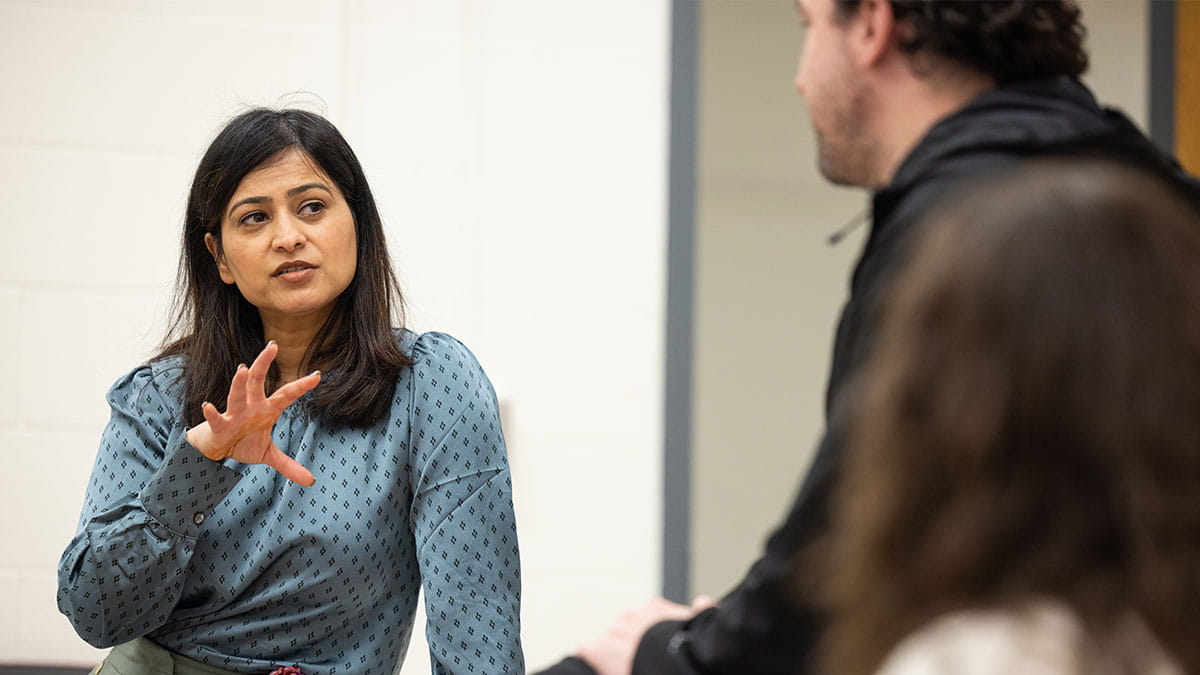New course helps learners address language barriers in patients with limited English proficiency

The Ohio State University Wexner Medical Center serves a substantial LEP population. Last year alone, the medical center provided health care services to 15,449 LEP individuals, resulting in 185,068 patient encounters. Leaders at the college are developing proactive initiatives to ensure that medical students excel in bridging the language barriers in health care.
One such effort is led by Taru Saigal, MD, clinical assistant professor of Internal Medicine and director of Community Health Education at the Ohio State College of Medicine, and Mark Troyer, MD, MPH, clinical assistant professor of Internal Medicine at the College of Medicine. They’ve created a new course that centers on caring for patients with LEP and the appropriate utilization of interpreter services. This innovative curriculum, titled Language Barriers, Health, and Healthcare for Populations with Limited English Proficiency, and Working with Medical Interpreters, is the outcome of collaboration among college faculty, internal medicine residents, the Office of Curriculum and Scholarship and Interpreter Services.
“Clear and effective communication is the cornerstone of exceptional patient care,” Dr. Saigal says. “However, this becomes challenging when health care professionals and patients do not share a common language, highlighting the crucial need for proper language interpreter services.”
Dr. Saigal emphasizes that increasing proficiency in using professional medical interpretation fills an important gap in medical education. She says learning is always better than trying and failing in health care.
To address this need, the team has taken innovative steps and approaches. On a recent Friday, in small, interactive classrooms, they conducted immersive simulation exercises. Within these dynamic scenarios, bilingual attending physicians and residents stepped into the roles of standard patients, actively participating in interviews conducted by medical students. 
“These bilingual attendings provide invaluable feedback to medical students,” Dr. Saigal says. “This helps elevate their proficiency in utilizing medical interpreters effectively during interactions with LEP patients.”
Simultaneously, in a lecture hall, Dr. Troyer conducted a case-based learning session with small groups of medical students. During these sessions, students gained insights into choosing the most suitable modality of medical interpretation, whether in-person or virtual through a medical transcription service. The curriculum also encompassed the nuanced art of identifying LEP patients, understanding legal and regulatory considerations, best practices in the use of medical interpreter services and exploring existing institutional language assistance and translation resources for LEP patients. They also gained a comprehensive understanding of these vital aspects.
“Teaching well-rounded students to understand what patients need to feel safe and supported so they’re able to share their symptoms and information in their language is key,” Dr. Troyer says. “Then they understand the why behind these vital aspects of delivering care.”
The session garnered significant attendance and enthusiastic participation from first-year medical students, who engaged actively, both individually and in groups. In her summary of the course, Mihika Aedla, a first-year medical student, highlights its relevance.
“As medical students, we are mastering the art of communication in every aspect of our lives, be it with patients or while presenting our findings,” Aedla says. “This course prepares us for unique challenges and how to navigate them, particularly when language barriers come into play.”
Another medical student, Samanda Valente, says that as an immigrant herself, she deeply understands the many emotions, including fear, nervousness and confusion, that come with accessing health care in a location different from your home country.
She says participating in this course brought her a step closer to bridging the gap in care for different patient populations by giving her concrete tools.
“At the end of the day, we all deserve quality care in a manner we understand,” Valente says. “And it is our duty as future health care professionals to do so in the best way possible.”
Dr. Troyer says understanding the difference between interpreting, which is the ability to go between spoken languages in real-time, and translating, which is the ability to translate written text, is an important first step for learners.
“Learners present information and ask questions one at a time,” Dr. Troyer says. “This gives the patient and the interpreter the time to finish sentences completely and ask for clarifications when needed.”
Dr. Saigal’s commitment to enhancing health care for LEP patients goes beyond the classroom. Recognizing language as a key social determinant of health, she advocates for the appropriate use of medical interpreter services, cultural competence training and the delivery of language-concordant care. In 2022, she pioneered the Language Concordant Program, where 15 additional faculty members provide primary care services in 14 different languages and dialects. Her visionary approach earned her Ohio State 2023 Distinguished Diversity Enhancement Award in recognition of her commitment to diversity and inclusion.
“The college is nationally recognized for our steadfast commitment to diversity and inclusion,” says Melissa Quinn, PhD, clinical associate professor of Biomedical Education and Anatomy and academic program co-director of Part One of the Lead. Serve. Inspire. Curriculum. “This innovative course perfectly aligns with our mission to prepare our students to address the unique needs of diverse patient populations and reduce health disparities.”
